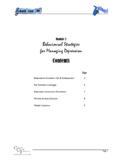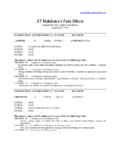Transcription of The Perils of Ignoring History: Big Tobacco Played …
1 The Perils of Ignoring History: Big TobaccoPlayed dirty and Millions Died. HowSimilar Is Big Food?KELLY D. BROWNELL and KENNETH E. WARNERYale University; University of MichiganContext:In 1954 the Tobacco industry paid to publish the Frank Statement toCigarette Smokers in hundreds of newspapers. It stated that the public shealth was the industry s concern above all others and promised a variety ofgood-faith changes. What followed were decades of deceit and actions that costmillions of lives. In the hope that the food history will be written differently,this article both highlights important lessons that can be learned from thetobacco experience and recommends actions for the food :A review and analysis of empirical and historical evidence pertainingto Tobacco and food industry practices, messages, and strategies to influencepublic opinion, legislation and regulation, litigation, and the conduct of.
2 The Tobacco industry had a playbook, a script, that emphasizedpersonal responsibility, paying scientists who delivered research that instilleddoubt, criticizing the junk science that found harms associated with smoking,making self-regulatory pledges, lobbying with massive resources to stifle gov-ernment action, introducing safer products, and simultaneously manipulatingand denying both the addictive nature of their products and their marketing tochildren. The script of the food industry is both similar to and different fromthe Tobacco industry :Food is obviously different from Tobacco , and the food industrydiffers from Tobacco companies in important ways, but there also are significantsimilarities in the actions that these industries have taken in response to concernthat their products cause harm.
3 Because obesity is now a major global problem,Address correspondence to:Kelly D. Brownell, Rudd Center for Food Policy andObesity, Yale University, 309 Edwards St., Box 208369, New Haven, CT06520-8369 (email: Milbank Quarterly, Vol. 87, No. 1, 2009 (pp. 259 294)c 2009 Milbank Memorial Fund. Published by Wiley Periodicals Brownell and Warnerthe world cannot afford a repeat of the Tobacco history, in which industry talksabout the moral high ground but does not occupy :Food, obesity, Tobacco , industry, ethics, politics, public December1953,the CEOs of the major tobaccocompanies met secretly in New York City.)
4 Their purpose was tocounter the damage from studies linking smoking to lung cancer. Ayear earlierReader s Digest then the public s leading source of medicalinformation had printed an article entitled Cancer by the Carton (Norr 1952). After it appeared, cigarette sales plummeted for two years,the first such decline of the century except during the Great closely with John Hill, the founder of the public relationsgiant Hill & Knowlton, the industry created A Frank Statement toCigarette Smokers and paid to have it published in 448 newspaperson January 4, 1954.
5 To give the industry a human face, the statementincluded the signatures of the nation s top Tobacco executives and as-sured Americans that we accept an interest in people s health as a basicresponsibility, paramount to every other consideration in our business. Furthermore, they promised that we always have and always will coop-erate closely with those whose task it is to safeguard the public s health ( Tobacco Industry Research Committee 1954).The Frank Statement was a charade, the first step in a concerted,half-century-long campaign to mislead Americansaboutthe catastrophiceffects of smoking and to avoid public policy that might damage later, industry documents showed the repeated duplicity ofits executives.
6 Everything was at stake. The industry wanted desperatelyto prevent, or at least delay, shifts in public opinion that would permita barrage of legislative, regulatory, and legal actions that would erodesales and another industry is under attack for marketing products per-ceived by some to damage health, and it also faces legislative, regulatory,and legal threats that could fundamentally alter how it does are banning soft drinks and snack foods; legislation requiringcalorie labels on restaurant menus has been passed at state and locallevels and is being considered nationally; restrictions in food marketingpractices have been proposed around the world; and even radical mea-sures such as taxing snack foods are part of the national debate.
7 SuchThe Perils of Ignoring History261actions invite comparison of the food and Tobacco industries, exempli-fied by aFortunemagazine cover story in 2003 entitled Is Fat the NextTobacco? The cover depicted a French fry lying in an ash tray as if itwere a cigarette. The article did what is now common debate the par-allels between Tobacco and food in the context of culpability for healthdamage and ask whether Big Food should be sued for the same reasonsthat Big Tobacco are, of course, differences between food and Tobacco as sub-stances.
8 The most obvious is that humans must eat to maintain healthand life, whereas the unnecessary activity of smoking is, in the wordsof former Secretary of Health, Education and Welfare Joseph Califano, slow-motion suicide. Moreover, selling Tobacco to children is illegal,but there currently are no restrictions on food sales. Tobacco has a well-chronicled addictive process, whereas research on food and addiction isjust now maturing. And although the fight against Tobacco coalescedaround a single product made by a few companies, food and its industriesare far more more important issue is whether Tobacco history is instructivein addressing the problems created by unhealthy diets.
9 A half cen-tury of Tobacco industry deception has had tragic consequences: Sincethe Frank Statement, approximately 16 million Americans have diedfrom smoking, and millions more have suffered from debilitating dis-eases ranging from emphysema to heart disease. Had the industry comeclean in 1954 matching deeds with promises many of these deathswould almost certainly have been prevented. No one knows how 3 million. Maybe 5 million. Maybe 7 million just in theUnited States. An honest approach by industry might have saved morelives than any public health measure taken during the past fifty , if industry had made good faith efforts globally, rather thanexploit and addict the developing world, the benefits could have , physical inactivity, and obesity may be in the same astonishing two-thirds of the adult population is overweightor obese (Ogden et al.)
10 2007). As with smoking, social justice issues areprominent, given that obesity rates are highest in the poorest segments ofthe population (Kumanyika 2006). But weight issues are hardly uniqueto the United States. The World Health Organization has declaredobesity a global epidemic, now surpassing hunger as the chief nutritionproblem, even in some developing countries (WHO 2004). Brownell and WarnerObesity rates are especially troubling in children, rising at threetimes the rate of increase in adults (Ogden, Carroll, and Flegal 2008).Indeed, the termadult onset diabeteshas now been scrapped and replacedwithType 2 diabetesbecause children as young as eight are developingthe disease.




